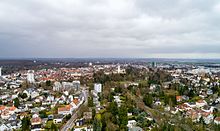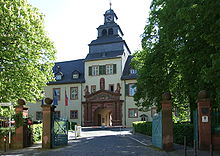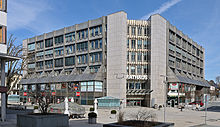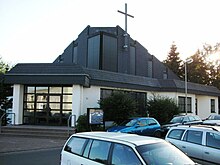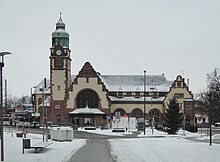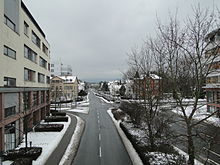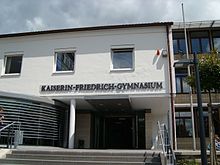Bad Homburg vor der Höhe
| coat of arms | Germany map | |
|---|---|---|

|
Coordinates: 50 ° 14 ' N , 8 ° 37' E |
|
| Basic data | ||
| State : | Hesse | |
| Administrative region : | Darmstadt | |
| County : | Hochtaunuskreis | |
| Height : | 194 m above sea level NHN | |
| Area : | 51.16 km 2 | |
| Residents: | 54,227 (Dec. 31, 2019) | |
| Population density : | 1060 inhabitants per km 2 | |
| Postcodes : | 61348, 61350, 61352 | |
| Area code : | 06172 | |
| License plate : | HG, USI | |
| Community key : | 06 4 34 001 | |
| LOCODE : | DE BHO | |
| City structure: | 7 districts | |
City administration address : |
Rathausplatz 1 61348 Bad Homburg v. d. height |
|
| Website : | ||
| Lord Mayor : | Alexander Hetjes ( CDU ) | |
| Location of the city of Bad Homburg v. d. Height in the Hochtaunuskreis | ||
Bad Homburg vor der Höhe (officially Bad Homburg v. D. Höhe ) is the district town of the Hochtaunuskreis and one of seven cities with a special status in the state of Hesse . Bad Homburg is a medicinal bath and is designated as a middle center according to the Hessian state development plan. The city sees itself as a spa and congress city and advertises itself with the motto “champagne air and tradition”.
The city of Bad Homburg with its 54,227 inhabitants (December 31, 2019) is located in the Rhine-Main conurbation and borders directly on Frankfurt am Main . The addition "Bad" has been used since November 22, 1912. Bad Homburg is internationally known as a spa town and for its casino , which is known as the "mother of Monte-Carlo ". The city is also known for its expensive residential area with a number of villa areas. The spa town, like some other Taunus towns , is the preferred residential area for commuters who work in Frankfurt and who usually earn well . At the same time, Bad Homburg is the seat of a number of companies whose workforce consists of more foreigners than locals. The city is the seat of the Federal Compensation Office and has an office of the Federal Office for Central Services and Unresolved Property Issues as well as a branch of the Federal Office of Administration .
In 2017, Bad Homburg had a purchasing power index of 154 percent of the national average, which is well above the national average, making it a top value nationwide. The development of rental prices is increasing if you compare the average rent excluding heating from 2018 (€ 11.8) to 2020 (€ 12.28).
geography
The city of Bad Homburg is 137 to 250 m above sea level. NN , on average at 194 meters.
Neighboring communities
Bad Homburg borders in the north on the municipality of Wehrheim and the city of Friedrichsdorf , in the east on the cities of Rosbach vor der Höhe and Karben (both Wetteraukreis ), in the south on the independent city of Frankfurt am Main , in the southwest on the city of Oberursel (Taunus) , to the west (to a small extent) to the community of Schmitten and to the north-west to the city of Neu-Anspach .
City structure
According to § 4 of the main statutes of the city of Bad Homburg vdHöhe , Bad Homburg has seven districts . There is a local advisory board for each district . The districts are as follows:
history


The name of the city of Homburg is derived from Hohenberg Castle . "The height" is the traditional name of the Taunus , the current name of which only became established in the 18th century.
The city of Homburg, today's Bad Homburg, was first documented around 1180. Archaeological investigations have provided evidence of settlement for the same period. The attribution of a mention of Villa Tidenheim = “Dietigheim” in the Lorsch Codex from 782 for the city is therefore unlikely.
There is also no clear evidence for the assumption that Homburg was given town and market rights around 1330 , because a corresponding document is not available. In 1335, however, Emperor Ludwig IV. , Called the Bavarian , allowed the Lords of Eppstein to settle ten Jews in the "Dal and Burg zu Hoenberg" area of their territory, as well as in Steinheim and Eppstein . Since Ludwig had already granted town charter to the two places mentioned, it is assumed that this also applied to Homburg; in the 15th century Homburg was only called a city.
In 1486 Gottfried X. von Eppstein sold the castle , office and city of Homburg for 19,000 guilders to Count Philipp I von Hanau-Münzenberg . In 1504/1521 Hanau Homburg lost again to the Landgraviate of Hesse as a result of the Landshut War of Succession , in which it was on the loser's side . When it was divided after the death of Landgrave Philip I , Homburg fell to Hessen-Darmstadt , and in 1622 to the Hessen-Homburg branch line . In 1866 Homburg fell back to the Grand Duchy of Hesse- Darmstadt after the Landgraves of Hesse-Homburg died out , but became Prussian in the same year as a result of the Austro- Prussian War .
With the emergence of the spa from the middle of the 19th century, which profited greatly from the establishment of a casino , the city transformed into an internationally famous spa .
After 1888, Bad Homburg became the summer residence of Kaiser Wilhelm II. Due to a state police order from the Wiesbaden district president, Homburg was allowed to prefix his name with a “bath” and to call himself Bad Homburg vor der Höhe from 1912 .
At the end of the Second World War, Bad Homburg was occupied by troops of the 3rd US Army on March 30, 1945 .
The spa business in Bad Homburg declined sharply, especially after the Second World War, in which the spa building was also badly damaged by bombs. Leading hotels have also been claimed by the military government . The importance of the city as the seat of authorities and administrations increased. As early as autumn 1946, the military government ordered the establishment of bizonal authorities. The administrative office for finance was based in Bad Homburg. Here on July 23, 1947, the Economic Council of the Bizone set up the “Special Office for Money and Credit” in preparation for the currency reform , of which Ludwig Erhard became the head . After the founding of the Federal Republic with its capital Bonn still remained in Bad Homburg Federal Debt Administration , which in 2002 Federal Securities Administration was renamed and since 1 August 2006 Part of the German Finance Agency is the Office of Securities cleanup and federal compensation Office .
In the course of the 20th century, Bad Homburg had become a preferred residence for wealthy Frankfurt families, a trend that intensified as a result of the destruction of the war in Frankfurt. On November 30, 1989, the spokesman for the board of directors of Deutsche Bank , Alfred Herrhausen , who lived in Bad Homburg, was killed by a bomb that terrorists detonated on his passing company car.
Incorporations
The incorporation of the surrounding villages began in 1901 with Kirdorf, followed by Gonzenheim in 1937. On December 31, 1971, as part of the regional reform in Hesse, Ober-Eschbach and Dornholzhausen were incorporated on a voluntary basis. On August 1, 1972, Ober-Erlenbach was incorporated by virtue of state law.
For the area of the incorporated communities Dornholzhausen, Ober-Eschbach and Ober-Erlenbach, local districts with local advisory councils and local councilors were established by the main statute . The boundaries of the local districts of Ober-Eschbach and Ober-Erlenbach follow the previous district boundaries. In addition to the Dornholzhausen district, the Dornholzhausen district includes parts of the Bad Homburg v. d. Höhe and Kirdorf, which are to the west of Bundesstrasse 456 (Saalburgchaussee / Hohemarkstrasse).
The village of Mittelstedten was already taken over in medieval times , with only the population being relocated to the city and the village being abandoned.
In addition to the incorporations, the eastward, now independent re-establishment of Friedrichsdorf, which started from Homburg during the Huguenot settlement, as well as the repopulation of the area of the Dornholzhausen desert, which is now a district of Bad Homburg again, should be mentioned.
politics
City Council
The local elections on March 6, 2016 produced the following results, compared to previous local elections:
| Parties and constituencies | 2016 | 2011 | 2006 | 2001 | ||||||||
|---|---|---|---|---|---|---|---|---|---|---|---|---|
| Share a | Seats | Share a | Seats | Share a | Seats | Share a | Seats | |||||
| Christian Democratic Union | CDU | 44.2 | 22nd | 40.3 | 20th | 42.2 | 21st | 38.3 | 23 | |||
| Social Democratic Party of Germany | SPD | 14.9 | 7th | 14.6 | 7th | 16.9 | 8th | 19.1 | 11 | |||
| Alliance 90 / The Greens | Green | 11.4 | 6th | 23.6 | 12 | 11.2 | 6th | 12.4 | 7th | |||
| Free Democratic Party | FDP | 10.7 | 5 | 7.1 | 3 | 10.7 | 5 | 8.8 | 5 | |||
| Bad Homburg citizens' list | SU | 6.6 | 3 | 6.1 | 3 | 8.6 | 4th | 12.1 | 7th | |||
| Alternative for Germany | AfD | 5.9 | 3 | - | - | - | - | - | - | |||
| Peter for Bad Homburg | PfB | 2.8 | 1 | - | - | - | - | - | - | |||
| The left | left | 2.7 | 1 | 2.0 | 1 | - | - | - | - | |||
| The Republicans | REP | 1.0 | 1 | 1.7 | 1 | 2.3 | 1 | 3.5 | 2 | |||
| New Homburg Union | NHU | - | - | 4.7 | 2 | 6.3 | 3 | - | - | |||
| The Left WASG | The Left WASG | - | - | - | - | 1.8 | 1 | - | - | |||
| Free Homburg voters | FHW | - | - | - | - | - | - | 5.9 | 4th | |||
| percentage of invalid votes | 2.9 | 3.9 | 3.3 | 2.4 | ||||||||
| Total seats | 49 | 49 | 49 | 59 | ||||||||
| voter turnout | 49.6% | 49.5% | 44.5% | 50.9% | ||||||||
Lord Mayor
| Lord Mayor | Political party | Term of office | annotation |
|---|---|---|---|
| Karl Tettenborn | - | 1892-1901 | since 1900 with the title of Lord Mayor |
| Ernst Ritter von Marx | - | 1901-1905 | since 1902 with the title of Lord Mayor |
| Konrad Maß | - | 1905-1907 | since 1905 with the title of Lord Mayor |
| Walter Lübke | DVP | 1907-1924 | since 1909 with the title of Lord Mayor |
| Georg Eberlein | DVP | 1924-1933 | mayor |
| Richard Hardt | NSDAP | 1933-1934 | acting mayor |
| Erich Meusel | NSDAP | 1933-1945 | mayor |
| Georg Eberlein | FDP | 1945-1948 | with title of Lord Mayor |
| Karl Horn | CDU | 1948-1962 | with title of Lord Mayor |
| Armin Klein | CDU | 1962-1980 | since 1979 with the title of mayor |
| Wolfgang Assmann | CDU | 1980-1998 | Lord Mayor |
| Reinhard Wolters | CDU | 1998-2003 | Lord Mayor; his election was subsequently declared invalid, so Wolters was never officially mayor. The decisions he made remained in effect. |
| Ursula Jungherr | CDU | 2003 to September 17, 2009 | Lord Mayoress |
| Michael Korwisi | Green | September 18, 2009 to September 17, 2015 | Lord Mayor |
| Alexander Hetjes | CDU | since September 18, 2015 | Lord Mayor |
The mayors of Homburg, the capital of the Landgraviate of Hessen-Homburg , were originally appointed by the respective sovereign. After the town and county fell to Prussia in 1866 , Emperor Wilhelm II, who regularly resided in the palace, as King of Prussia , bestowed the title of Lord Mayor as a personal honor to the mayors who had been in office since 1892 , albeit in some cases only one or two years after taking office as mayor. After the end of the monarchy this designation was no longer given to city leaders.
Georg Eberlein was allowed to use the title of Lord Mayor after 1945 due to the determination of the occupation authorities ; The state government allowed his successor Karl Horn to do so. Since 1979, all city leaders have held the title of mayor , as Bad Homburg has become a "city with a special status".
Mayor election 2009
Ursula Jungherr (CDU) was Lord Mayor from December 2003 to September 2009. A black-yellow coalition has ruled since the local elections in 2006. In the Mayor election on April 26, 2009 Ursula Jungherr received 39.0 percent, the challenger Michael Korwisi (Greens), who had run as an independent, 39.3 percent. The Social Democratic candidate , Karl Heinz Krug, received 21.7 percent of the vote. On May 10, 2009, there was a runoff election between Ursula Jungherr and Michael Korwisi. Ursula Jungherr achieved 40.5 percent of the votes, challenger Michael Korwisi received 59.5 percent of the vote in Bad Homburg. The turnout of 45.8 percent was a few percentage points higher than in the first ballot. Michael Korwisi's term of office began on September 18, 2009. After the 2011 local elections, Korwisi forged a minority alliance of the Greens, SPD, SU and NHU, which, with the help of the left, elected a new mayor and a new full-time city council. In the summer of 2014, the alliance broke up due to secret talks between the SPD and the CDU. Since then, the city council has ruled with varying majorities.
Mayor election 2015
In the Mayor election on June 14, 2015, Michael Korwisi, who ran again as an independent, received 29.8 percent of the vote. Mayor Krug (SPD) came to 22.2 percent and the chairman of the CDU parliamentary group in the city council, Alexander Hetjes, 48.0 percent. In the runoff election on June 28, 2015, Alexander Hetjes received 61.5 percent of the vote. Incumbent Michael Korwisi came to 38.5 percent. The turnout was 46.1 percent, almost the same as in the first round of voting. Alexander Hetjes' term of office began on September 18, 2015.
coat of arms
|
Blazon : "The city coat of arms shows two white (silver) hooks on a blue background with a four-pointed wall crown."
The place of the Lords of Eppstein , endowed with town charter between 1320 and 1337, used a stamp in the diagonal cross position in the first seals since the early 15th century, from which today's coat of arms first developed in the seal around 1550. The picture is probably speaking for the place name in the earlier form "Howenberg". The colors have been known since the replica of the coat of arms in the hall of Rotenburg Castle (1577) by Wessel in 1621, and were officially confirmed again in 1908. At that time, the city colors blue and white were also determined. The city colors are blue and white. |
|
Sister cities / sponsored cities
Sister cities are:
-
 Chur , Switzerland
Chur , Switzerland
-
 Dubrovnik , Croatia
Dubrovnik , Croatia
-
 Exeter , UK
Exeter , UK
-
 Marienbad , Czech Republic (in 1953 the city took on the sponsorship of the displaced Sudeten Germans Marienbader, since August 3, 1991 city partnership )
Marienbad , Czech Republic (in 1953 the city took on the sponsorship of the displaced Sudeten Germans Marienbader, since August 3, 1991 city partnership ) -
 Mayrhofen , Austria
Mayrhofen , Austria
-
 Peterhof , Russia
Peterhof , Russia
-
 Terracina , Italy
Terracina , Italy
-
 Bad Mondorf , Luxembourg
Bad Mondorf , Luxembourg
-
 Cabourg , France
Cabourg , France
Project partnerships
Former twin town
In 1956 a town twinning between Bejaia and Bad Homburg was agreed before the height. At that time it was the only town twinning with Algeria and only one of six between Germany and Africa. When Ben Bellas came to power in 1963, this town twinning was ended on the Algerian side. The attempt to reactivate the twinning by the mayor Bejaias in 1975 failed.
religion
Catholic parishes
The diocese of Limburg includes:
- Parish of St. Marien with the branch churches Herz Jesu and Heilig Kreuz
- St. Marienkirche in the city center, built by Ludwig Becker
- Holy Cross Church in Gonzenheim, built in 1952/1953, with an organ built in 1867 by the English manufacturer J. W. Walker for the English Church, which was then donated to the Holy Cross community by the city of Bad Homburg in 1953
- Herz-Jesu-Kirche in the Gartenfeldsiedlung
- St. Johannes Church in Kirdorf
- Community center St. Franziskus in Kirdorf
- Italian municipality Bad Homburg
The diocese of Mainz includes:
- St. Elisabeth in Ober-Eschbach
- St. Martin in Ober-Erlenbach
Evangelical parishes
- Christ Church in the Berlin settlement (city center)
- English Church , 1868–1914 used as a place of worship for English and American spa guests, today a cultural center in the city center
- Church of the Redeemer in the city center, built according to plans by Max Spitta and Franz Schwechten
- Evangelical Church in Gonzenheim
- Memorial Church in Kirdorf
- Waldensian Church in Dornholzhausen
- To the Himmelspforte in Ober-Eschbach
Russian Orthodox Church
- All Saints Church , Russian chapel in the spa park
Free Churches
- Evangelical Free Church Congregation - Bad Homburg is also the seat of the Federation of Evangelical Free Church Congregations in Germany, the European Baptist Federation and the savings and credit bank of Evangelical Free Church congregations .
- Evangelical Community Bad Homburg
Jewish community
A Jewish community had existed in Bad Homburg since the late Middle Ages. In 1639 eleven Jews are counted. The number of Jews increased significantly in the further course. In 1803 there were 105 families and around 1925 the Jewish community consisted of around 400 people, around 2.5 percent of the then 16,000 inhabitants.
The Jewish community ceased to exist after the synagogue was destroyed in the pogrom night in 1938 and the last four Jewish citizens were deported by the National Socialists on May 20, 1943.
Since 2013 there has been a Jewish center again with a permanent rabbi in Bad Homburg, which was located in provisional, rented premises. There are currently around 300 Jews living in Bad Homburg, mainly from the former Soviet Union, as well as another 300 Jewish citizens in the area around Bad Homburg. The center is looked after and administered by the Frankfurt Jewish Community. The new synagogue was inaugurated on November 11, 2018. The city of Bad Homburg has signed a long-term lease for the building with the association “Friends and Patrons of Jewish Culture and Religion Bad Homburg”.
At the site of the former synagogue on Elisabethenstrasse there is now an open space that is used as a playground. A memorial and a bronze plaque commemorate the synagogue and the Jewish victims of the National Socialist tyranny. The square in front of it was renamed “Square of the Former Synagogue”.
Other religious communities
Economy and Infrastructure
Bad Homburg has a purchasing power index of 154 percent, which is well above the average . The above-average purchasing power of the resident population is very advantageous for the Bad Homburg retail trade, a small part flows into the neighboring Frankfurt retail trade. The inner city is kept politically attractive; Settlements, for example of discount stores on the outskirts, are prohibited. This led to a rapid expansion of the industrial areas bordering the Bad Homburg urban area in the Frankfurt districts of Nieder-Eschbach and Kalbach-Riedberg . In the meantime, compared to neighboring towns with also high purchasing power, Bad Homburg is now higher than that, around 96 out of 100 euros are also spent here. In comparison, it is just under 66 euros in Oberursel, 51 euros in Königstein and 30 euros in Kronberg.
Bad Homburg's quality of life, which is regarded as particularly high, means that land prices in the spa town are among the highest in the whole of Germany.
Bad Homburg is the seat of a number of companies whose workforce consists of more foreigners (around 27,000 commuters) than locals (around 12,000 outbound commuters). The following companies, among others, have their headquarters in the city: Amadeus Germany , Basler Securitas Versicherung , Bridgestone Germany, Delton , Deutsche Leasing , Feri Finance , Fresenius , Hewlett-Packard , Ixetic , Lilly Germany , Kawasaki Gas Turbine Europe , Kewill, WD -40 Company , Linotype , MEDA Pharma , PIV-Drives , Ringspann , the administration of the Quandt Group and Syzygy .
Horex was a well-known German motorcycle brand from Horex - Fahrzeugbau , which was founded in 1923 by Fritz Kleemann in Bad Homburg. A Horex museum was therefore created in Bad Homburg . The 1.6 million euro new building near the now demolished Horex factory was opened in September 2012.
In addition, the city is the seat of the headquarters for combating unfair competition , the AOK Hessen and the Bad Homburg casino . Also here is one of the headquarters of the Taunus Sparkasse .
With the Landgräflich Hessischen Landesbank in Homburg , Bad Homburg was the seat of a central bank between 1855 and 1876 . After the Second World War, the Federal Compensation Office and the Federal Debt Administration had their headquarters in Bad Homburg.
Spa and tourism

An important economic factor is the spa , which is based on the numerous medicinal springs . Center of Kurbetriebs is built in 1982 to 1984, post-modern new spa . The traditional Kaiser-Wilhelms-Bad is located in the Bad Homburg spa gardens , a 44- hectare park in the English landscape style based on a design by Peter Joseph Lenné on the eastern edge of the city center. The lower part of the park is best known for the many wells, which are relatively close together, but sometimes have very different mineral contents.
A number of clinics offer all kinds of therapeutic treatments. In addition to the Hochtaunus clinics and the Hochtaunus district clinics , these include the Wickerklinik, Klinik Wingertsberg, Klinik Dr. Baumstark and the Paul Ehrlich Clinic.
In addition to the health resort, the city and the surrounding area offer well-known sights to day visitors in particular:
- Gothic house
- Deer garden
- Saalburg Castle
- Bad Homburg Castle
- Sinclair House - Exhibition House for Modern Art
See also the list of fountains in Bad Homburg vor der Höhe .
Leisure pool and thermal baths
Bad Homburg has two well-known leisure pools: the Seedammbad and the Taunus-Therme.
The Seedammbad is a city-owned adventure and leisure pool. In addition to solariums and saunas, a 50-meter sports pool, a water treading facility , whirlpools, several children's pools and a tube slide are available all year round in the indoor area . The specialty of the Seedammbad is the so-called "adventure pool". This pool with water mushrooms, syringes, massage jets, slides, carousel, tunnel and flow channel is located as part of the indoor pool under a glass dome that can be opened in good weather. When the dome is open, this pool is part of the large outdoor pool. The outdoor pool has an additional three swimming pools, a diving tower, a children's pool, a children's playground and huge lawns. The fact that the entrance fees are highly subsidized by the city contributes to the popularity of the bath.
The Taunus-Therme is located directly opposite the Seedammbad on the edge of the spa park. The privately operated recreational and health bath offers a full nudist sauna world with a separate ladies sauna area, dream world 1001 nights with hammam paradise, fragrance temples and an oasis tour, a thermal bath area with various indoor and outdoor pools with thermal water from the Viktoria Louise spring . There are also various whirlpools, a torrent, bubble loungers, sunbathing gardens and a gastronomic offer. Another feature for health seekers is the therapy in the exercise pool, which is carried out several times a day in close cooperation with the German Rheumatism League , the regular yoga lessons and the salt grotto in the sauna world.
traffic

Bad Homburg is by the train - S5 on the Homburg Railway connected to Frankfurt. The Bad Homburg train station is also the terminus of municipal Taunusbahn . It connects the district town with the towns of the Hintertaunus and is connected to Frankfurt main station during rush hour . In Bad Homburg there is a city bus network with 22 lines. The operator was Alpina Bad Homburg on behalf of the city until 2008, and from January 1, 2009 to December 31, 2015, the Mittelhessen transport company . On January 1, 2016, Transdev took over the operation for nine years.
There are also eight regional bus routes that connect the city with Schmitten, Weilrod , Grävenwiesbach , Friedrichsdorf, Karben , Bad Vilbel , Weilmünster , Weilburg , Kronberg and Königstein. Since 1995 all connections have belonged to the Rhein-Main-Verkehrsverbund .
From 1899 to 1935, was the electric tram Bad Homburg the electricity AG formerly W. Lahmeyer & Co. This included the 1900 opened hall funicular to the Roman Fort Saalburg in the Taunus. From 1910 to 1962, electric trains of the Frankfurt Local Railway ran from Frankfurt along Louisenstraße to the market, then only to the old station, today's town hall. The line has been used by the U2 tram to Gonzenheim since December 19, 1971 . The planning approval process is currently underway to continue this tram line to Bad Homburg station.
Earlier considerations of extending the subway through Bad Homburg to the Northwest Sports Center and even over the Saalburg in the Hintertaunus in order to give commuters on the congested federal highway 456 an incentive to switch to local public transport are currently no longer being pursued.
Bad Homburg is at the foot of the Saalburg Pass , the road connection between Frankfurt and the Usinger Land. Today the busy federal road 456 runs here. The conversion of the Peters-Pneu intersection in Bad Homburg, through a tunnel solution to avoid the daily traffic jam, is politically highly controversial in Bad Homburg. Three exits from the 661 federal motorway open up Bad Homburg. The Bad Homburg Cross is the junction between the A 661 and A 5 .
media
- Taunus-Zeitung, regional edition of the Frankfurter Neue Presse for the Hochtaunus district
- Bad Homburg Week, advertising paper with extensive editorial content
- Regional supplement to the Frankfurter Rundschau
- Rhein-Main-Zeitung, regional edition of the Frankfurter Allgemeine Zeitung
In addition, from 2003 to 2014 Bad Homburg was the location of the regional television broadcaster Rheinmaintv for the Rhine-Main area.
Authorities, courts and institutions
Bad Homburg has the following authorities, courts and institutions:
- Federal agency for work
- Federal Office for Central Services and Unresolved Property Issues, Bad Homburg headquarters
- Federal Compensation Office , Bad Homburg headquarters
- Federal Office of Administration , Bad Homburg branch
- District office of the Hochtaunus district
- Tax office Bad Homburg v. d. height
- District court Bad Homburg v. d. height
- Chamber of Commerce and Industry Bad Homburg v. d. Height, office
education
Elementary schools
- Friedrich Ebert School, Gonzenheim
- Dornholzhausen primary school
- Elementary school in the Eschbachtal, Ober-Eschbach
- Hölderlin School, Bad Homburg
- Ketteler-Francke-School, Kirdorf
- Landgraf Ludwig School, Bad Homburg
- Paul Maar School, Ober-Erlenbach
Further training
- accadis International School Bad Homburg - international bilingual high school
- Kaiserin-Friedrich-Gymnasium - Gymnasium with upper level
- Humboldt School - grammar school with upper level
- Comprehensive school am Gluckenstein - Comprehensive school with a gymnasium entry level, without a gymnasium upper level
- Maria Ward School - private secondary school and vocational high school for girls
- Feldbergschule - vocational school , Bad Homburg branch, BGJ and BVJ
Colleges
Other schools
- International Language School - private language school
- Maria Scholz School - special needs school
- Adult education center / music school
Culture and sights
Cultural event
Since 1997, a sculpture exhibition with renowned contemporary sculptors has been held every two years in the spa gardens, combined with a sponsorship competition under the name Blickachsen . In addition, since 1989 every year on June 6th, the day before Friedrich Hölderlin died , the Friedrich-Hölderlin-Prize of the city of Bad Homburg has been awarded together with a sponsorship prize.
Since 1995, Fugato , an international organ festival with world-famous musicians and another sponsorship award, has taken place every two years . In addition , the Bad Homburg Lantern Festival has been held on the first weekend in September since 1935 ( interrupted due to the Second World War) .
In 2000, the Bad Homburg Palace Concerts were brought back to life.
Bad Homburg foundations
In Bad Homburg there is the Bleib Gesund Foundation, which awards the Oskar Kuhn Prize , the Else Kröner Fresenius Foundation , the Flersheim Foundation, the Fritz Acker Foundation for the promotion of medical research for the benefit of the general public Herbert Quandt Foundation of the Altana, the Johanna Quandt Foundation , the Martin-Carl-Adolf-Böckler-Foundation, which organizes the "Homburg Talks", the non-profit patient home care as well as the foundation, which Johann Christian Rind had in his will in 1776 . Also the Rotary-Bad Homburg-Schloss-Foundation and the Werner-Reimers-Foundation .
Sporting events
The 1904 Gordon Bennett Race put Bad Homburg at the center of the sports world.
Sports clubs in Bad Homburg
- AFC Bad Homburg Sentinels, American Football, founded in 2015
- Bad Homburg rock'n'roll dance center eight to six, founded in 1981
- Bad Homburg swimming club 1927
- Baseball and softball club Bad Homburg Hornets , founded July 7, 1992, baseball league
- Budokan Bad Homburg, founded in 1957, is the oldest karate club in Germany
- DJK SV Helvetia Bad Homburg-Kirdorf 1920
- FC Bomber Bad Homburg
- Hockey Club Bad Homburg, founded on July 10, 1921
- Royal Homburger Golf Club 1899, the Old Course in the Kurpark is the oldest golf course in Germany. It has been used since 1889
- Homburg Riding and Driving Association, founded in 1898
- Homburg Rifle Society 1390
- Homburg gymnastics community , founded in 1846
- Luftsportclub Bad Homburg, operator of the Anspach airfield
- RSG Fichtenhof, Fichtenhof equestrian center
- Chess Club Bad Homburg 1927
- SG Ober-Erlenbach
- SGK Bad Homburg 1890
- SpVgg Bad Homburg
- Tennis club in the Kurpark, founded in 1876, the oldest tennis club on the mainland
- TSG Ober-Eschbach
- TSV Vatanspor Bad Homburg
- TV Gonzenheim 1894
- TSV Ober-Erlenbach
- TTC Ober-Erlenbach 1987, table tennis
Social clubs in Bad Homburg
- Bad Homburg hospice service
- Bad Homburg Forest Children
- Federation of Displaced Persons Local Association Bad Homburg
- Citizen Aid Bad Homburg
- Taunus scouts
- White ring
Sculpture avenue
The sculpture avenue between the train station and the town hall in Bad Homburg is a green area next to the building of the former federal debt administration, today's technical town hall of the city administration, in which a number of sculptures by well-known artists are exhibited.
Erwin Wortelkamp , "For Lenné", 2001
Kenny Hunter , Red Boy, 2007
Karl Menzen , Dance Solo, 2008
Hanneke Beaumont , Melancholia I, 2009
Sean Henry , Walking Woman, 2008
Monuments
The Bad Homburg Palace Park extends around Bad Homburg Palace, a landscaped garden based on the English model and part of the Bad Homburg Landgrave Gardens , which line up to the Gothic House.
The spa gardens include monuments to Friedrich Hölderlin , Peter Joseph Lenné , Wilhelm Filchner , Maximilian Oskar Bircher-Benner , the Emperors Wilhelm I , Wilhelm II and Friedrich III. as well as his wife Victoria .
A memorial in Elisabethenstrasse commemorates the new synagogue of 1864, which was destroyed during the November pogrom in 1938, and the deportation of the Bad Homburg Jews in 1942.
In the forest garden there is the natural monument Krausbäumchen , a Süntel beech . However, today's young sapling is only a replacement for the original specimen that fell victim to a storm in 1966. The Rabenstein rock group , also a natural monument, can be found near Kirdorf. The Gluckenstein is located on the boundary between Kirdorf and Bad Homburg .
The war memorial 1870/71 was erected on Waisenhausplatz in 1875 .
Between the Taunus-Therme and the Seedammbad, three basalt steles commemorate Alfred Herrhausen, who was murdered at this point .
About seven kilometers northwest of the city center rises the Herzberg with a lookout tower at 591 meters .
Bad Homburg as a novel material
The novel “In Dinge Mensch”, written by Ursula Rütt, who has lived there since 1948, and her husband Walter headed the local criminal investigation office, was published in 1955 by Steinberg Verlag in Zurich. Its almost 300 pages attracted considerable attention and were the focus of three legal proceedings between 1955 and 1958; the title was temporarily confiscated. The author, for libel and slander accused is acquitted later, the seizure lifted the book. In her book, Rütt describes the actions of the city administration and other local authorities as well as life in the city, which is never mentioned by name. Rütt uses aliases for the characters involved and emphasizes the "ominous mixture of nepotism and corruption, adultery and homosexuality". After the publication of the book, according to local historian Dieter Metz, "everyday life was no longer bearable for many of those affected". The Rütt couple died in 2002 under unknown circumstances in Provence , where they had been living for several years.
See also
- Homburg (hat)
- List of the largest cities in Hessen
- Evangelical cemetery Bad Homburg vor der Höhe
- Mine gold mine
Personalities
literature
- Christoph Kaufmann: Short trip to Bad Homburg - the travel guide for the curious. Duck-Media, Berlin 2018, ISBN 978-3-930748-06-8 .
- Heinz Grosche: History of the Jews in Bad Homburg before the height: 1866 to 1945. Kramer, Frankfurt am Main 1991, ISBN 3-7829-0412-5 .
- Erich Gunkel: Bad Homburg v. d. Height: impressions of a city. Gehlen, Bad Homburg v. d. Height, 1990. ISBN 3-441-00152-4 .
- Friedrich Hofmann: Lively Bad Homburg in front of the height: His past u. Present. The team of four, Bad Homburg v. d. Height 1960.
- Andreas Mengel: Collecting, organizing, storing, evaluating: from the history of the Bad Homburg v. d. Height. Bad Homburg vor der Höhe 2002, ISBN 3-933921-05-8 .
- Hilde Miedel (Ed.): Bad Homburg vor der Höhe 782–1982: Contribution to history, art and literature. Bad Homburg 1983.
- Walter Söhnlein: Bad Homburg vor der Höhe - 150 years of public transport and urban structure. Verlag Zeit und Eisenbahn, Landsberg-Pürgen 1978, ISBN 3-921304-41-6 .
- Walter Söhnlein, Gerta Walsh: Clear the way! - Railways in the Taunus. Frankfurt 2010, ISBN 978-3-7973-1223-5 .
- Rolf Palm: I'll give you Monte Carlo: Foundation of the Bad Homburg casino by François Blanc. Luebbe Publishing Group, ISBN 3-404-00598-8 .
- Literature on Bad Homburg in front of the height in the Hessian Bibliography
- Literature from and about Bad Homburg vor der Höhe in the catalog of the German National Library
Web links
|
Further content in the sister projects of Wikipedia:
|
||
|
|
Commons | - multimedia content |
|
|
Wiktionary | - Dictionary entries |
|
|
Wikisource | - Sources and full texts |
|
|
Wikinews | - News |
|
|
Wikivoyage | - Travel Guide |
- Official website of the city of Bad Homburg v. d. height
- Bad Homburg, Hochtaunuskreis. Historical local dictionary for Hessen. In: Landesgeschichtliches Informationssystem Hessen (LAGIS).
- Research for cultural monuments in Bad Homburg (512 data sets)
- Bad Homburg in the photo collection of Doorn Castle
- Link catalog on the subject of Bad Homburg vor der Höhe at curlie.org (formerly DMOZ )
Individual evidence
- ↑ Hessian State Statistical Office: Population status on December 31, 2019 (districts and urban districts as well as municipalities, population figures based on the 2011 census) ( help ).
- ↑ Law on the final regulation of individual questions on the occasion of municipal reorganization (final reorganization law) of October 26, 1976 . In: The Hessian Minister of the Interior (ed.): Law and Ordinance Gazette for the State of Hesse . 1976 No. 23 , p. 428 ff ., Article 1, Paragraph 2 a) ( Online at the information system of the Hessian State Parliament [PDF; 740 kB ]).
- ↑ a b Bad Homburg in brief: numbers, data, facts . City of Bad Homburg v. d. Height. Retrieved July 23, 2013.
- ↑ Rent index Bad Homburg vor der Höhe 2020 - Current rental prices in Bad Homburg vor der Höhe. Retrieved January 24, 2020 .
- ↑ a b c main statute of the city of Bad Homburg vdHöhe, Hochtaunuskreis, administrative district Darmstadt. (PDF) In: bad-homburg.de. City of Bad Homburg v. d. Höhe, December 19, 1978, accessed on January 27, 2019 (amended by the Articles of Association of April 24, 2008 and December 22, 2017).
- ^ F. Lotz: History of the city of Bad Homburg before the height. Vol. 1, Frankfurt am Main 1977, p. 159.
- ↑ Evelyn Brockhoff, Bernd Heidenreich, Sönke Neitzel (eds.): Polis No. 45: 1945: End of the war and a new beginning. HLZ (PDF file; 2.1 MB) p. 43ff.
- ^ Federal Statistical Office (ed.): Historical municipality directory for the Federal Republic of Germany. Name, border and key number changes in municipalities, counties and administrative districts from May 27, 1970 to December 31, 1982 . W. Kohlhammer, Stuttgart / Mainz 1983, ISBN 3-17-003263-1 , p. 373 .
- ↑ Law on the reorganization of the Obertaunus district and the district of Usingen (GVBl. II 330-18) of July 11, 1972 . In: The Hessian Minister of the Interior (ed.): Law and Ordinance Gazette for the State of Hesse . 1972 No. 17 , p. 227 , § 8 ( online at the information system of the Hessian state parliament [PDF; 1,2 MB ]).
- ↑ Karl-Heinz Meier barley: Hesse. Municipalities and counties after the regional reform. A documentation. Melsungen 1977, p. 267.
- ^ Result of the municipal election on March 6, 2016. Hessian State Statistical Office, accessed in April 2016 .
- ↑ Hessian State Statistical Office: Results of the municipal elections of 2011 and 2006.
- ↑ Hessian Statistical Office: Results of the municipal elections of 2001 and 1997.
- ^ Result of the mayor runoff election 2009. ( Memento from May 13, 2009 in the Internet Archive ) City of Bad Homburg v. d. height
- ↑ Fabian Böker: Bad Homburg: Karasu doesn't want to be a “voting cattle”. Frankfurter Rundschau, July 31, 2014, accessed on April 28, 2016 .
- ↑ a b Mayor election 2015. City of Bad Homburg v. d. height
- ^ Wilhelm Wessel: Hessisches Wappenbuch. Kassel 1623.
- ^ Klemens Stadler : The municipal coat of arms of the state of Hesse . New edition of the collection of German local coats of arms by Prof. Otto Hupp on behalf of HAG Aktiengesellschaft in Bremen, edited by Dr. Klemens Stadler, drawings by Max Reinhart (= German coat of arms - Federal Republic of Germany . Volume 3 ). Angelsachsen-Verlag, Bremen 1967, p. 17 .
- ↑ Sister cities. City of Bad Homburg v. d. Height. Retrieved April 7, 2014.
- ↑ Johannes Latsch: Dead End to Africa. In: Yearbook of the Hochtaunuskreis 2008 , ISBN 978-3-7973-1049-1 , pp. 164–166.
- ↑ Cf. Art. 1, Paragraph 2 of the Constitution of the BEFG ( Memento of 23 September 2015 in the Internet Archive ). The central office of the BEFG is now in Wustermark -Elstal while in Bad Homburg just some specific tasks that still remain.
- ^ Alemannia Judaica : The synagogue in Bad Homburg v. d. Height. Retrieved September 29, 2016.
- ↑ http://www.fr.de/rhein-main/alle-gemeinden/hochtaunus/juedischer-friedhof-trauerhalle-gehoert-zur-seele-der-stadt-a-1001649
- ↑ http://www.fr.de/rhein-main/alle-gemeinden/hochtaunus/bad-homburg-neue-synagoge-wird-eingeweiht-a-1615697
- ↑ Miriam Keilbach: News from the Kulturbahnhof. Frankfurter Rundschau of June 4, 2012, accessed on June 4, 2012.
- ↑ A chic home for the Horex. Frankfurter Rundschau from July 20, 2012, accessed on September 24, 2012.
- ↑ Ready for Steffi Graf and Barack Obama . In: FAZ of February 7, 2012, p. 39
- ↑ Olaf Velte: Details from the civil service life. Sixty years ago, the scandalous novel “In Dinge Mensch” caused a stir in Bad Homburg. In: Frankfurter Rundschau of October 28, 2015, p. D7.







